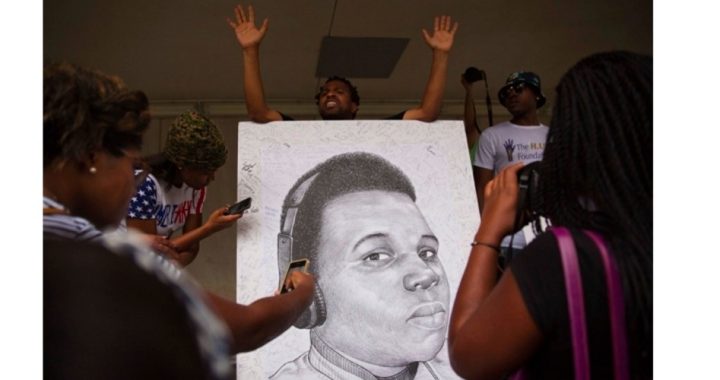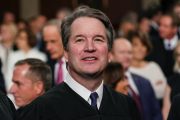
Unlike Trayvon Martin, pictures of a 12-year-old Michael Brown haven’t been used to portray him as a gentle little cherub. Instead the media has cast him as the “gentle giant.” And they’re at least partially right, say critics. Brown certainly was a giant, as surveillance footage seems to prove, showing his 6’4”, nearly 300-pound self towering over a petrified convenience-store employee, who got manhandled and intimidated for having the temerity to object to his store being robbed.
This characterization lies in stark contrast to the picture painted by Brown’s family, friends, and that sympathetic media. Brown’s uncle, Charles Ewing, who related the gentle-giant moniker, said that the family tried to get the young man to play football, but he “was too timid for the sport,” reported the Washington Post. “‘He had never gotten into a fight in his entire life,’ said Duane Finnie, a family friend. At school, he was that kid who was full of jokes and trying to make others laugh,” continued the paper. In fact, the Post article opened by stating that Brown had just won a “hard-fought victory,” having recently graduated from high school, a note accompanied by a graduation photo of a gown-bedecked Brown.
Now, critics might say that education — even if it is something more impressive than that acquired at Brown’s Normandy High, which had already lost its state accreditation — doesn’t definitively denote goodness. Neither does accomplishment. But isn’t it to be expected that Brown’s defenders will relate facts about the young man’s history in order to establish his character? For sure. It’s also to be expected, however, that his whole history will then be fair game, say critics.
One of these critics, award-winning investigative reporter Matthew Vadum, leaves no doubt about where he stands. In a piece entitled “Michael Brown: A Criminal and a Thug,” he writes:
Before the shooting incident last weekend, Brown used violence and the threat of more violence to steal. With an accomplice, he knocked over a convenience store, bullying victims with his prodigious size and weight. (Incidentally, the owner of the store told the Washington Post he fears that his customers will murder him and that he begged reporters not to suggest that he called the police on Brown.)
And as the Los Angeles Times reports, Brown also enjoyed singing violent rap songs that contain “lots of boasting about murdering, taking drugs, drinking, and sex with hos,” as blogger Sancho Panza put it. How bad are the lyrics? Panza deciphers some of them for us. About a song labeled “Jennings Station Road Freestyle,” the blogger writes:
This one specifically talks about killing people and how fun it is. The main rapper talks about how his favorite part of killing people is when they hit the ground.
Every time I call your b**** I make her c*m
And when she comes I’m c*****g all over her tush
I beat that p***y up
I’m smoking purple
I roll fat blunts they look just like my thumb
While I bless him with a d*** on his face
And about “Free$tyle Big’Mike,” Panza reports:
In this rap song, one of the rappers talks about killing someone and seeing them “layin’ across the street.” The victim is said to be “mashed up and black” like a goblin so “there ain’t describing him.”
With this Glock in your face
And you betta not make a sound
And I only like white men on my money [???]
Those who are last shall be first,
Whites on the bottom
He musta walked up and unloaded because there was no stopping him
Somebody else layin’ across the street, must be his partner
Damn.
At his site Panza has more examples of Brown songs, all of which he characterizes as “pretty obscene.”
Then there’s blogger Pat Dollard, who has published numerous photos of Brown flashing what appear to be gang signs. Here is a sampling of them (article continues beneath photos):


Of course, this doesn’t mean Brown actually was a gang member. He likely was just a “wannabe,” one of countless black youths who listen to violent and vile rap and adopt the signs and mannerisms of the lamentably exalted “gangsta’” culture. But this is still meaningful. As Vadum pointed out, while Brown’s musical and gestural inclinations don’t in and of themselves mean he was a thug, they do “provide insight into his state of mind.”
But talking about such things is quite unfair, say Brown’s defenders. One, Democrat Missouri Governor Jay Nixon, said that the release of the convenience-store video was an attempt “to disparage the character [of Brown]” and that making it public “in the middle of a process like this is not right.” And Nixon isn’t alone: Barack Obama’s Department of Justice also wanted the Ferguson police to suppress the video.
Making note of this double standard, Vadum wrote, “So, first local police were condemned for not being sufficiently transparent; then after they released a key piece of evidence they were condemned for being too transparent.” In the same vein, about Governor Nixon’s condemnation of Ferguson Police Chief Thomas Jackson for a defense of the police that the governor fancies an attack on Brown’s character, Vadum stated, “This means Nixon believes that Jesse Jackson Sr. and Al Sharpton, who have been making campaign stops in Ferguson, have every right to be heard while the local police at the heart of the case should just remain silent and take whatever abuse is hurled at them.”
Yet critics might say that even more hypocrisy is evident here, in that the Brown case is all about character assassination — and, sadly, stereotyping. The Ferguson police are being portrayed as white law-enforcement officials who, the stereotype goes, are inherently prejudiced against young black men. In fact, the United States is being stereotyped as an irredeemably biased land in which blacks just can’t get a fair shake. But there is a difference: The convenience-store video and other information about Brown concern not something purely the function of stereotype-driven character assassination, but particulars about an individual central to what is currently the biggest crime story in the nation.
And the gentle-giant narrative took another blow over the weekend. An eyewitness conversation previously unnoticed in a video of the Brown shooting’s aftermath was brought to light, and it corroborates the Ferguson police’s account of the event. Unfortunately, some may say, all the evidence seems to be taking a back seat to the desire to appease the violent mobs that have made Ferguson a war zone. Perhaps, as we see in the response to Islamists in Europe, one good riot is worth a thousand truths.
Photo at the beginning of the article shows a sketch of Michael Brown that has been autographed by demonstrators during a protest in Atlanta: AP Images



